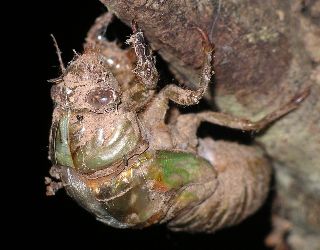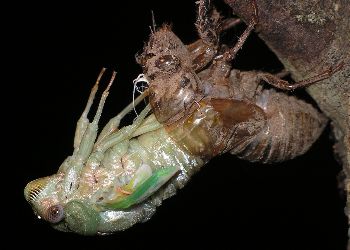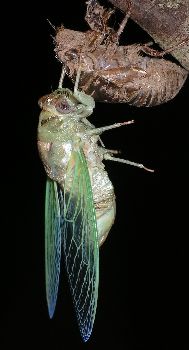
| Cicadidae ~ Cicadas |
As a family, cicadas are so distinctive that they cannot be mistaken for anything else. Trying to get a species identification, though, can be almost impossible. It helps to hear the songs and there are now internet resources that provide recordings of the various species. Cicadas are relatively large insects, with most species being 25-30 mm in length.
One species in our area is easy to identify because it is the tiniest cicada imaginable. The Little Mesquite Cicada (Pacarina puella) is really LITTLE. It measures only about 13 mm in length, and emerges during a short period in June. Other cicadas tend to be more prevalent later in the summer. Cicadas spend most of their lives underground, eating roots and other plant material. Sometimes this is just a few years, as in the case of our annual cicadas, and we see them every year. Other times it is longer, as in the case of the periodical cicadas, which emerge as adults only every 13 or 17 years. We do not have any of these insects in the Austin area. Adult cicadas do not feed, but instead put all their energy into mating and laying eggs. The females lay eggs at the tips of tree branches, which often causes the end of the branch to die. This acts as a natural pruning, and only hurts very small trees. Most of our more numerous cicadas belong to the genus Tibicen. These are the Dog-Day Cicadas, a name describing their peak numbers time in late summer. Only the Green Cicada (Tibicen superba) is easy to recognize because of its obvious bright green color and black mask. Other Tibicen species are frustratingly similar in appearance. The markings on the pronotum are often a useful feature, as well as any abdominal markings. One that I'm sure of is Tibicen resh, which is pretty common in our yard and was identified for me by an expert. I'm also rather certain of Tibicen pruinosa, which has a mostly green head and two obvious white spots on the abdomen where it meets the thorax. Size of most of these species is very similar, ranging from about 20-30 mm for body length. The songs of cicadas often help with their identification. The Texas Cicada (Tibicen texanus) has an incessant, whiny sort of call. The insect shown below continued to sing while I pulled it off a branch and put it on a rock to photograph. Other cicadas sometimes let out a distress buzz when handled, but this one was determined to keep singing no matter what!
In spite of the abundance of Tibicen species, there is at least one other similar genus: Diceroprocta. I'm not sure of the species on this one, but the general look of the insect is slightly different, and it is rather on the small side, at about 20 mm in length. The lack of small dark markings in the wings also separates Diceroprocta species from most Tibicen species. One of the most notable aspects of cicadas, besides the fact that they are among the loudest insects on the planet, is their final molt, when they emerge from their larval shells and become winged adults for their last few days of life. They always try to climb up on something to gain height once they leave the ground. This is because they are heavy-bodied and have trouble getting airborne. Often, they use the sides of houses or trees, and almost always molt under the cover of darkness to avoid predators while they are so vulnerable. The whole process from when the skin splits to when the wings are their full size takes less than an hour, but is slow enough to provide a good look at every stage. The following sequence is of Tibicen resh: |




 
|
![]()





